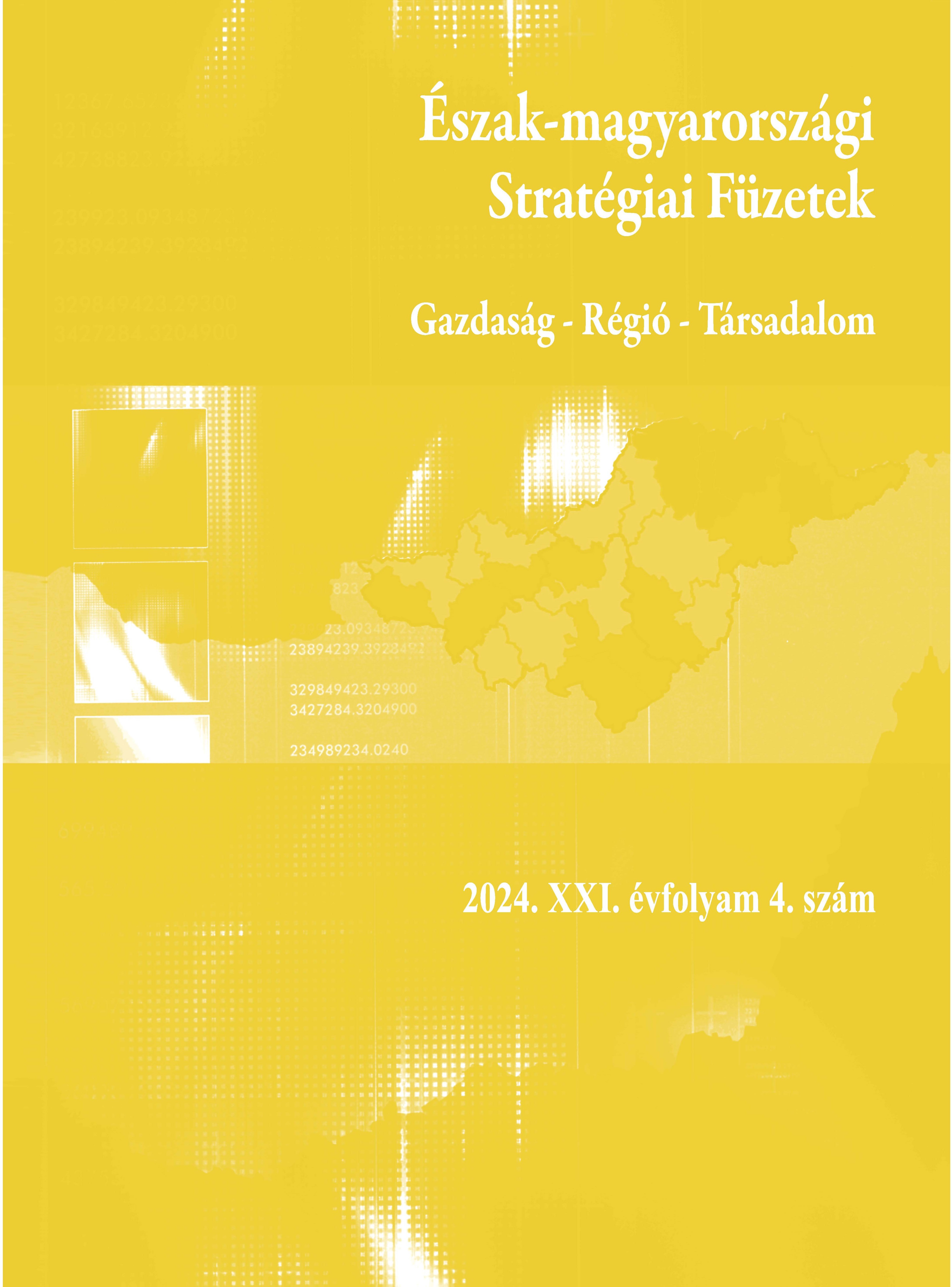Challenges in defining and measuring social resilience
DOI:
https://doi.org/10.32976/stratfuz.2024.38Kulcsszavak:
resilience, social resilience, indicator set, social science, definitionAbsztrakt
Over the past two decades, resilience has gained considerable popularity in both social and economic sciences, reinforced by the effects of various economic and social shocks and the pandemic that has spread worldwide. On the other hand, more and more detailed and extensive studies have been launched on the various types of resilience (social, economic, ecological, etc.), which, in addition to the undoubtedly useful scientific results, have highlighted the elusive nature of the phenomenon and the lack of a centripetal force to channel the various lines of research in a single direction and unify the various interpretative frameworks.
The paper attempts to provide a conceptual overview of one type of resilience, social resilience, based on the available theoretical framework. With the help of previous research results, I will define a set of indicators for this concept to test and verify it in the context of empirical research. Refining the indicator set and the definition also provides an opportunity to distinguish between different types of resilience partially, thus contributing to a more accurate scientific understanding. The added value of the paper is that some of the indicator groups have been tested empirically, thus demonstrating the scientific value of the method.
Hivatkozások
Adger, W. N. (2000). Social and ecological resilience: Are they related? Progress in Human Geography, 24(3), 347–364. https://doi.org/10.1191/030913200701540465
Brand, F., & Jax, K. (2007). Focusing the meaning(s) of resilience: Resilience as a descriptive concept and a boundary object. Ecology and Society, 12(1). https://doi.org/10.5751/ES-02029-120123
Bueno, S., Bañuls, V. A., & Gallego, M. D. (2021). Is urban resilience a phenomenon on the rise? A Systematic Literature Review for the Years 2019 and 2020 Using Textometry. International Journal of Disaster Risk Reduction, 66, 102588. https://doi.org/10.1016/j.ijdrr.2021.102588
Cai, H., Lam, N. S. N., Qiang, Y., Zou, L., Correll, R. M., & Mihunov, V. (2018). A Synthesis of Disaster Resilience Measurement Methods and Indices. International Journal of Disaster Risk Reduction, 31, 844–855. https://doi.org/10.1016/j.ijdrr.2018.07.015
Chandler, D. (2015). A neoliberalizmuson túl: reziliencia, a komplexitás kormányzásának új módja. Replika, 94(5), 25–44.
Csizovszky, A., & Buzási, A. (2023). Analysis of Community Resilience in Hungary - An Adaptation of the Basic Resilience Indicators for Communities (BRIC), 2020. Regional Statistics, 13(4), 752–778. https://doi.org/10.15196/RS130408
Davidson, J. L., Jacobson, C., Lyth, A., Dedekorkut-Howes, A., Baldwin, C. L., Ellison, J. C., Holbrook, N. J., Howes, M. J., Serrao-Neumann, S., Singh-Peterson, L., & Smith, T. F. (2016). Interrogating Resilience: Toward a Typology to Improve Its Operationalization. Ecology and Society, 21(2), Article 27. https://doi.org/10.5751/ES-08450-210227
Folke, C. (2016). Resilience (Republished). Ecology and Society, 21(4), Article 44. https://doi.org/10.5751/ES-09088-210444
Grabner, S. M. (2021). Regional Economic Resilience: Review and Outlook. In R. Wink (Ed.), Economic Resilience in Regions and Organisations, Studien Zur Resilienzforschung (pp. 21–55). Wiesbaden: Springer Fachmedien. https://doi.org/10.1007/978-3-658-32630-8_2
Gyurasicsné Fazekas, N. (2024). A rugalmasság és a versenyképesség összefüggései Nyugat-Dunántúl példáján, 1960-2020. Területi Statisztika 64(1), 51–70. https://doi.org/10.15196/TS640103
Keck, M., & Sakdapolrak, P. (2013). What Is Social Resilience? Lessons Learned and Ways Forward. Erdkunde, 67(1), 5–19. https://doi.org/10.3112/erdkunde.2013.01.02
Keijzer, R., van der Rijst, R., van Schooten, E., & Admiraal, W. (2021). Individual Differences among At-Risk Students Changing the Relationship between Resilience and Vocational Identity. International Journal of Educational Research, 110, 101893. https://doi.org/10.1016/j.ijer.2021.101893
Kwok, A. H., Doyle, E. E. H., Becker, J., Johnston, D., & Paton, D. (2016). What Is “Social Resilience”? Perspectives of Disaster Researchers, Emergency Management Practitioners, and Policymakers in New Zealand. International Journal of Disaster Risk Reduction, 19, 197–211. https://doi.org/10.1016/j.ijdrr.2016.08.013
Lester, T. W., & Nguyen, M. T. (2016). The Economic Integration of Immigrants and Regional Resilience. Journal of Urban Affairs, 38(1), 42–60. https://doi.org/10.1111/juaf.12205
Maclean, K., Cuthill, M., & Ross, H. (2014). Six Attributes of Social Resilience. Journal of Environmental Planning and Management, 57(1), 144–156. https://doi.org/10.1080/09640568.2013.763774
Mahler, B. (2023). Regionalitás és reziliencia. Autonómia & Társadalom, 3(2), 94–101. https://doi.org/10.52895/AT.2023.3.2.7
Mahler, B. (2024). The Meaning of Social Resilience: Interdisciplinary Status or a New Viewpoint? In M. Sávai (Ed.), Green and Digital Transitions (pp. 175–191). Szeged: Szegedi Tudományegyetem.
Martin, R. (2012). Regional Economic Resilience, Hysteresis and Recessionary Shocks. Journal of Economic Geography, 12(1), 1–32. https://doi.org/10.1093/jeg/lbr019
Martin, R., & Sunley, P. (2015). On the Notion of Regional Economic Resilience: Conceptualization and Explanation. Journal of Economic Geography, 15(1), 1–42. https://doi.org/10.1093/jeg/lbu015
Nagy, Z., Tóth, G., & Szép, T. (2022). A Magyarországi Városok Rezilienciájának Vizsgálata. Észak-magyarországi Stratégiai Füzetek, 19(3), 84–99. https://doi.org/10.32976/stratfuz.2022.37
Pirisi, G. (2017). A reziliencia szerepe a kisvárosok fejlődésében – egy komlói esettanulmány kapcsán. Településfejlesztési Tanulmányok, 6, 75–88.
Pirisi, G. (2019). A reziliencia lehetséges értelmezése a településföldrajzi kutatásokban. Tér és Társadalom, 33(2), 62–81. https://doi.org/10.17649/TET.33.2.3080
Saja, A. M. A., Goonetilleke, A., Teo, M., & Ziyath, A. M. (2019). A Critical Review of Social Resilience Assessment Frameworks in Disaster Management. International Journal of Disaster Risk Reduction, 35, 101096. https://doi.org/10.1016/j.ijdrr.2019.101096
Scherzer, S., Lujala, P., & Rød, J. K. (2019). A Community Resilience Index for Norway: An Adaptation of the Baseline Resilience Indicators for Communities (BRIC). International Journal of Disaster Risk Reduction, 36, 101107. https://doi.org/10.1016/j.ijdrr.2019.101107
Stone-Jovicich, S. (2015). Probing the Interfaces Between the Social Sciences and Social-Ecological Resilience: Insights from Integrative and Hybrid Perspectives in the Social Sciences. Ecology and Society, 20(2), Article 25. https://doi.org/10.5751/ES-07347-200225
Suleimany, M., Mokhtarzadeh, S., & Sharifi, A. (2022). Community Resilience to Pandemics: An Assessment Framework Developed Based on the Review of COVID-19 Literature. International Journal of Disaster Risk Reduction, 80, 103248. https://doi.org/10.1016/j.ijdrr.2022.103248
Székely, I. (2015). Reziliencia: a rendszerelmélettől a társadalomtudományokig. Replika, 94, 7–23.
Varga, K. (2021). A lokális szintű társadalmi innovációs folyamat mérési kihívásai. Észak-magyarországi Stratégiai Füzetek, 18(Különszám), 16–34. https://doi.org/10.32976/stratfuz.2021.2
Yang, M., Wang, J., Jing, Z., Liu, B., & Niu, H. (2022). Evaluation and Regulation of Resource-Based City Resilience: Evidence from Shanxi Province, China. International Journal of Disaster Risk Reduction, 81, 103256. https://doi.org/10.1016/j.ijdrr.2022.103256
##submission.downloads##
Megjelent
Hogyan kell idézni
Folyóirat szám
Rovat
License

This work is licensed under a Creative Commons Attribution-NonCommercial-NoDerivatives 4.0 International License.







